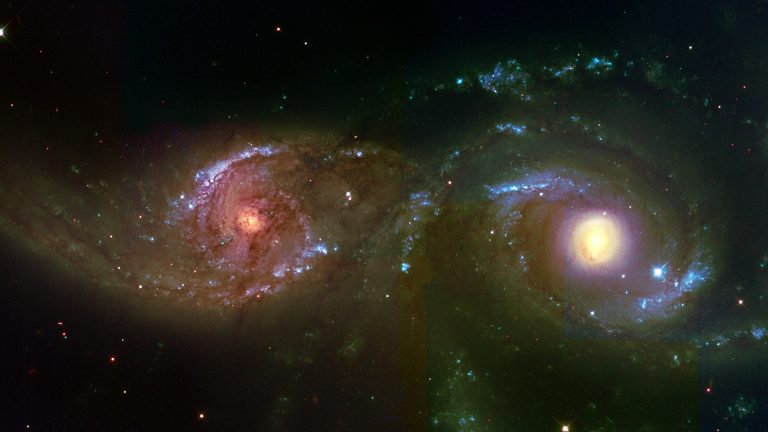JWST & HST examine galaxy pair IC 2163 & NGC 2207
Posted: Sat Nov 09, 2024 1:09 pm
Webb and Hubble examine spooky galaxy pair
space.com | Original release 2024 October 31
My Universe Hub New APOD-Image-Search
BSN4Y Jac
space.com | Original release 2024 October 31
[...]
- An image of spiral galaxies IC 2163 and NGC 2207 produced from observations made by the Hubble space telescope and James Webb Space Telescope. Hubble's data are from its Wide Field Planetary Camera 2 (WFPC2) and Webb's data were gathered by its MIRI (Mid-Infrared Instrument). This image shows invisible ultraviolet, visible, and mid-infrared wavelengths of light that have been translated into visible-light colors. The color key shows which WFPC2 and MIRI filters were used when collecting the light. The color of each filter name is the visible-light color used to represent the infrared light that passes through that filter. (Image credit: NASA, ESA, CSA, STScI)
This pair of galaxies is currently in the process of colliding and merging into one, a process that will take around a billion years.
The James Webb Space Telescope (JWST) and Hubble Space Telescope teamed up to image two spiral galaxies known as IC 2163 and NGC 2207 as they appeared millions of years ago. That's because the pair of colliding galaxies resides some 80 million light-years away in the Canis Major constellation. This pair of galaxies is currently in the process of colliding and merging into one, a process that will take around a billion years. "Stare deeply at these galaxies," the JWST team wrote in a statement accompanying the new images. "They appear as if blood is pumping through the top of a flesh-free face. The long, ghastly 'stare' of their searing eye-like cores shines out into the supreme cosmic darkness."
[...]
"The galaxies’ first pass may have also distorted their delicately curved arms, pulling out tidal extensions in several places. The diffuse, tiny spiral arms between IC 2163’s core and its far left arm may be an example of this activity. Even more tendrils look like they’re hanging between the galaxies’ cores. Another extension ‘drifts’ off the top of the larger galaxy, forming a thin, semi-transparent arm that practically runs off screen." NASA/ESA
[...]
The very blue spot on the HST picture (bottom right), known as future eye, is a hub of rapid star formation on the outer arm of NGC 2207 glowing even more brightly (espacially in IR) than the galaxy’s core.
... read more
... slider
... bigg
My Universe Hub New APOD-Image-Search
BSN4Y Jac





